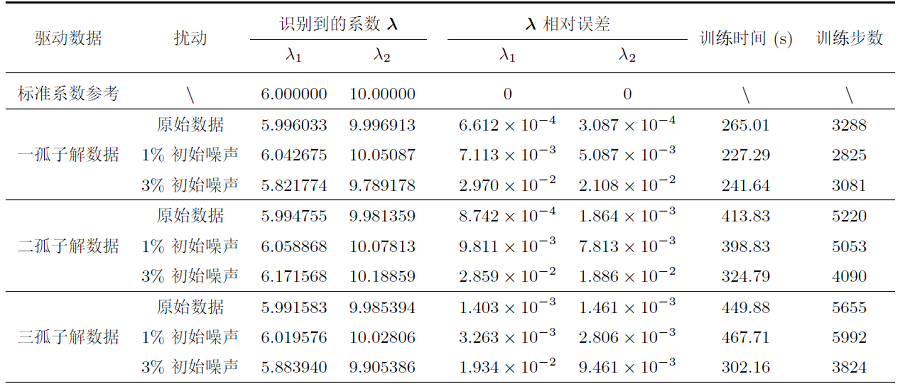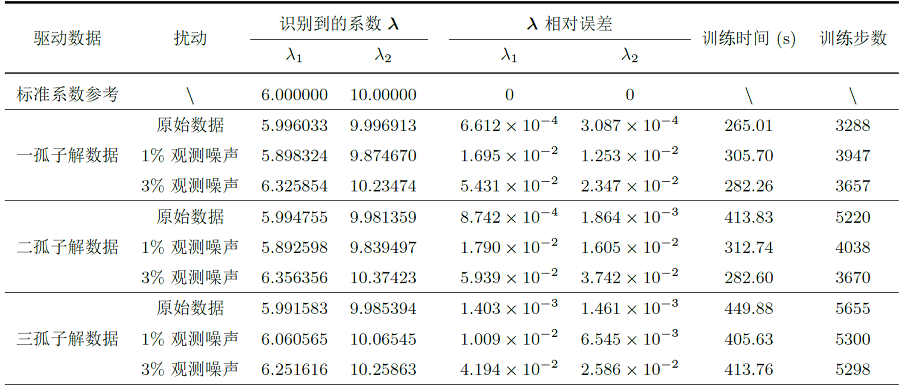数学物理学报 ›› 2024, Vol. 44 ›› Issue (2): 484-499.
物理信息神经网络求解五阶 emKdV 方程的正反问题
- 齐鲁工业大学 (山东省科学院) 数学与统计学院 济南 250353
-
收稿日期:2023-05-08修回日期:2023-10-17出版日期:2024-04-26发布日期:2024-04-07 -
通讯作者:* 王晓丽, Email:wxlspu@qlu.edu.cn -
基金资助:国家自然科学基金(12275017);山东省自然科学基金(ZR2020MA049)
Solving the Forward and Inverse Problems of Extended Fifth-Order mKdV Equation Via Physics-Informed Neural Networks
Wu Zekang,Wang Xiaoli*( ),Han Wenjing,Li Jinhong
),Han Wenjing,Li Jinhong
- School of Mathematics and Statistics, Qilu University of Technology (Shandong Academy of Science), Jinan 250353
-
Received:2023-05-08Revised:2023-10-17Online:2024-04-26Published:2024-04-07 -
Supported by:NSFC(12275017);Natural Science Foundation of Shandong Province(ZR2020MA049)
摘要:
该文利用物理信息神经网络 (PINNs) 对扩展的五阶 mKdV (emKdV) 方程的正反问题进行求解, 并对孤子的动力学行为进行分析、模拟. 针对正问题, 选用双曲正切函数 $\tanh$ 作为激活函数求解方程的一、二、三孤子解, 并将 PINNs 方法求得的数据驱动解与借助简化的 Hirota 方法给出的方程精确解进行比较, 一孤子解的精度为 $\mathcal{O}(10^{-4})$, 二、三孤子解的精度为 $\mathcal{O}(10^{-3})$. 针对反问题, 分别由一、二、三孤子解的数据进行驱动求解方程的两个待定系数, 并在不同的噪声下探究算法的鲁棒性. 当在训练数据中加入 1% 的初始噪声或观测噪声时, 待求系数的预测精度可分别达到 $\mathcal{O}(10^{-3})$ 和 $\mathcal{O}(10^{-2})$; 当加入 3% 的初始噪声或观测噪声时, 预测精度依然可以达到 $\mathcal{O}(10^{-2})$; 由实验数据分析可知观测噪声对 PINNs 模型的影响要略大于初始噪声.
中图分类号:
- O241.8
引用本文
吴泽康, 王晓丽, 韩文静, 李金红. 物理信息神经网络求解五阶 emKdV 方程的正反问题[J]. 数学物理学报, 2024, 44(2): 484-499.
Wu Zekang, Wang Xiaoli, Han Wenjing, Li Jinhong. Solving the Forward and Inverse Problems of Extended Fifth-Order mKdV Equation Via Physics-Informed Neural Networks[J]. Acta mathematica scientia,Series A, 2024, 44(2): 484-499.
| [1] | Draper L. Freak wave. Mar Obs, 1965, 35(2): 193-195 |
| [2] |
Haus H A, Wong W S. Solitons in optical communications. Rev Mod Phys, 1996, 68(2): 423-444
doi: 10.1103/RevModPhys.68.423 |
| [3] |
Zabusky N J, Kruskal M D. Interaction of "solitons" in a collisionless plasma and the recurrence of initial states. Phys Rev Lett, 1965, 15(6): 240-243
doi: 10.1103/PhysRevLett.15.240 |
| [4] |
Parkins A S, Walls D F. The physics of trapped dilute-gas Bose-Einstein condensates. Phys Rep, 1998, 303(1): 1-80
doi: 10.1016/S0370-1573(98)00014-3 |
| [5] |
Wadati M. The modified Korteweg-de Vries equation. J Phys Soc Jpn, 1973, 34(5): 1289-1296
doi: 10.1143/JPSJ.34.1289 |
| [6] | 黄念宁. 孤子理论和微扰方法. 上海: 上海科技教育出版社, 1996 |
| Huang N N. Theory of Solitons and Method of Pertubations. Shanghai: Shanghai Scientific and Technological Education Press, 1996 | |
| [7] |
Leblond H, Grelu P, Mihalache D. Models for supercontinuum generation beyond the slowly-varying-envelope approximation. Phys Rev A, 2014, 90(5): 053816
doi: 10.1103/PhysRevA.90.053816 |
| [8] |
Ono H. Soliton fission in anharmonic lattices with reflectionless inhomogeneity. J Phys Soc Jpn, 1992, 61(12): 4336-4343
doi: 10.1143/JPSJ.61.4336 |
| [9] |
Khater A H, El-Kalaawy O H, Callebaut D K. Bäcklund transformations and exact solutions for Alfvén solitons in a relativistic electron-positron plasma. Phys Scr, 1998, 58(6): 545
doi: 10.1088/0031-8949/58/6/001 |
| [10] |
Ito M. An extension of nonlinear evolution equations of the KdV (mKdV) type to higher orders. J Phys Soc Jpn, 1980, 49(2): 771-778
doi: 10.1143/JPSJ.49.771 |
| [11] |
Marchant T R, Smyth N F. Soliton interaction for the extended Korteweg-de Vries equation. IMA J Appl Math, 1996, 56(2): 157-176
doi: 10.1093/imamat/56.2.157 |
| [12] | Marchant T R, Smyth N F. The extended Korteweg-de Vries equation and the resonant flow of a fluid over topography. J Fluid Mech, 1990, 221: 263-287 |
| [13] | Wazwaz A M, Xu G Q. An extended modified KdV equation and its Painlevé integrability. Nonlinear Dyn, 2016, 86: 1455-1460 |
| [14] |
GrimShaw R, PelinovSky E, Poloukhina O. Higher-order Korteweg-de Vries models for internal solitary waves in a stratified shear flow with a free surface. Nonlin Processes Geophys, 2002, 9(3/4): 221-235
doi: 10.5194/npg-9-221-2002 |
| [15] | Pelinovskii E N, Polukhina O E, Lamb K. Nonlinear internal waves in the ocean stratified in density and current. Oceanology, 2000, 40(6): 757-766 |
| [16] | Wang X, Zhang J L, Wang L. Conservation laws, periodic and rational solutions for an extended modified Korteweg-de Vries equation. Nonlinear Dyn, 2018, 92: 1507-1516 |
| [17] |
Liu N, Guo B L, Wang D S, et al. Long-time asymptotic behavior for an extended modified Korteweg-de Vries equation. Commun Math Sci, 2019, 17(7): 1877-1913
doi: 10.4310/CMS.2019.v17.n7.a6 |
| [18] | Baydin A G, Pearlmutter B A, Radul A A, et al. Automatic differentiation in machine learning: a survey. J March Learn Res, 2018, 18: 1-43 |
| [19] | Raissi M, Perdikaris P, Karniadakis G E. Physics-informed neural networks: A deep learning framework for solving forward and inverse problems involving nonlinear partial differential equations. J Comput Phys, 2019, 378: 686-707 |
| [20] |
Li J, Chen Y. Solving second-order nonlinear evolution partial differential equations using deep learning. Commun Theor Phys, 2020, 72(10): 105005
doi: 10.1088/1572-9494/aba243 |
| [21] |
Li J, Chen Y. A deep learning method for solving third-order nonlinear evolution equations. Commun Theor Phys, 2020, 72(11): 115003
doi: 10.1088/1572-9494/abb7c8 |
| [22] | Li J H, Chen J C, Li B. Gradient-optimized physics-informed neural networks (GOPINNs): a deep learning method for solving the complex modified KdV equation. Nonlinear Dyn, 2022, 107: 781-792 |
| [23] |
田十方, 李彪. 梯度优化物理信息神经网络 (GOPINNs): 求解复杂非线性问题的深度学习方法. 物理学报, 2023, 72(10): 100202
doi: 10.7498/aps.72.20222381 |
|
Tian S F, Li B. Gradient-optimized physics-informed neural networks (GOPINNs): a deep learning method for solving complex nonlinear problems. Acta Phys Sin, 2023, 72(10): 100202
doi: 10.7498/aps.72.20222381 |
|
| [24] |
Wang L, Yan Z Y. Data-driven rogue waves and parameter discovery in the defocusing nonlinear Schrödinger equation with a potential using the PINN deep learning. Phys Lett A, 2021, 404: 127408
doi: 10.1016/j.physleta.2021.127408 |
| [25] |
Cui S K, Wang Z, Han J Q, et al. A deep learning method for solving high-order nonlinear soliton equations. Commun Theor Phys, 2022, 74(7): 075007
doi: 10.1088/1572-9494/ac7202 |
| [26] |
Li J H, Li B. Mix-training physics-informed neural networks for the rogue waves of nonlinear Schrödinger equation. Chaos, Solitons & Fractals, 2022, 164: 112712
doi: 10.1016/j.chaos.2022.112712 |
| [27] | Jin P Z, Lu L, Tang Y F, et al. Quantifying the generalization error in deep learning in terms of data distribution and neural network smoothness. Neural Networks, 2020, 130: 85-99 |
| [28] | Lu L, Meng X H, Mao Z P, et al. DeepXDE: A deep learning library for solving differential equations. SIAM Rev, 2021, 63: 208-228 |
| [29] |
Wang S F, Yu X L, Perdikaris P. When and why PINNs fail to train: A neural tangent kernel perspective. J Comput Phys, 2022, 449: 110768
doi: 10.1016/j.jcp.2021.110768 |
| [30] | Son H, Jang J W, Han W J, et al. Sobolev training for physics informed neural networks. arXiv proprint arXiv: 2101. 08932.2021 |
| [31] |
Liu D C, Nocedal J. On the limited memory BFGS method for large scale optimization. Math Program, 1989, 45(1): 503-528
doi: 10.1007/BF01589116 |
| [32] |
Stein M. Large sample properties of simulations using Latin hypercube sampling. Technometrics, 1987, 29(2): 143-151
doi: 10.1080/00401706.1987.10488205 |
| [33] |
Jiao Y L, Lai Y M, Li D W, et al. A rate of convergence of physics informed neural networks for the linear second order elliptic pdes. Commun Comput Phys, 2022, 31(4): 1272-1295
doi: 10.4208/cicp |
| [1] | 何娅, 安静. 周期边界条件下四阶特征值问题的一种有效的 Fourier 谱逼近[J]. 数学物理学报, 2024, 44(1): 37-49. |
| [2] | 曾纪尧,李剑. Cahn-Hilliard方程的自适应间断有限体积元法[J]. 数学物理学报, 2023, 43(4): 1255-1268. |
| [3] | 王阳,李剑,李祎,秦毅. 非定常 Stokes/Darcy 模型一种新的time filter 算法的分析[J]. 数学物理学报, 2023, 43(3): 829-854. |
| [4] | 于一康,牛晶. 一类椭圆型界面问题的数值算法[J]. 数学物理学报, 2023, 43(3): 883-895. |
| [5] | 建芒芒, 郑素佩, 封建湖, 翟梦情. 浅水波方程熵稳定格式的保平衡性[J]. 数学物理学报, 2023, 43(2): 491-504. |
| [6] | 黄媛,支越,康彤,王然,张红. 非线性感应加热问题的全离散有限元方法[J]. 数学物理学报, 2022, 42(4): 1238-1255. |
| [7] | 刘莹,高建芳. 一类自变量分段连续系统的振动性分析[J]. 数学物理学报, 2022, 42(3): 826-838. |
| [8] | 罗一鸣,李订芳,刘敏,董建. 一种维持Saint-Venant方程组移动稳态解的中心格式[J]. 数学物理学报, 2022, 42(3): 891-903. |
| [9] | 孟庆春,张磊. 一类三维逆时热传导问题的数值求解[J]. 数学物理学报, 2022, 42(1): 187-200. |
| [10] | 邓海云,刘辉,宋文静. 临界Schrödinger映射非齐次初边值问题的有限差分格式[J]. 数学物理学报, 2021, 41(5): 1311-1322. |
| [11] | 郑素佩,徐霞,封建湖,贾豆. 高阶保号熵稳定格式[J]. 数学物理学报, 2021, 41(5): 1296-1310. |
| [12] | 王克彦,王奇生. 一类非线性双曲型方程扩展混合有限元方法的误差估计[J]. 数学物理学报, 2021, 41(2): 468-478. |
| [13] | 葛志昊,李瑞华. Bogoliubov-Tolmachev-Shirkov模型临界温度和能隙解的数值方法[J]. 数学物理学报, 2020, 40(6): 1699-1711. |
| [14] | 赵晓龙,邱美兰,蔚喜军,卿芳,邹世俊. 一种非结构网格上求解拉格朗日形式可压缩欧拉方程的二阶RKDG方法[J]. 数学物理学报, 2020, 40(5): 1354-1361. |
| [15] | 闫朝琳,高建芳. 混合型脉冲微分方程的数值振动性分析[J]. 数学物理学报, 2020, 40(4): 993-1006. |
|
























